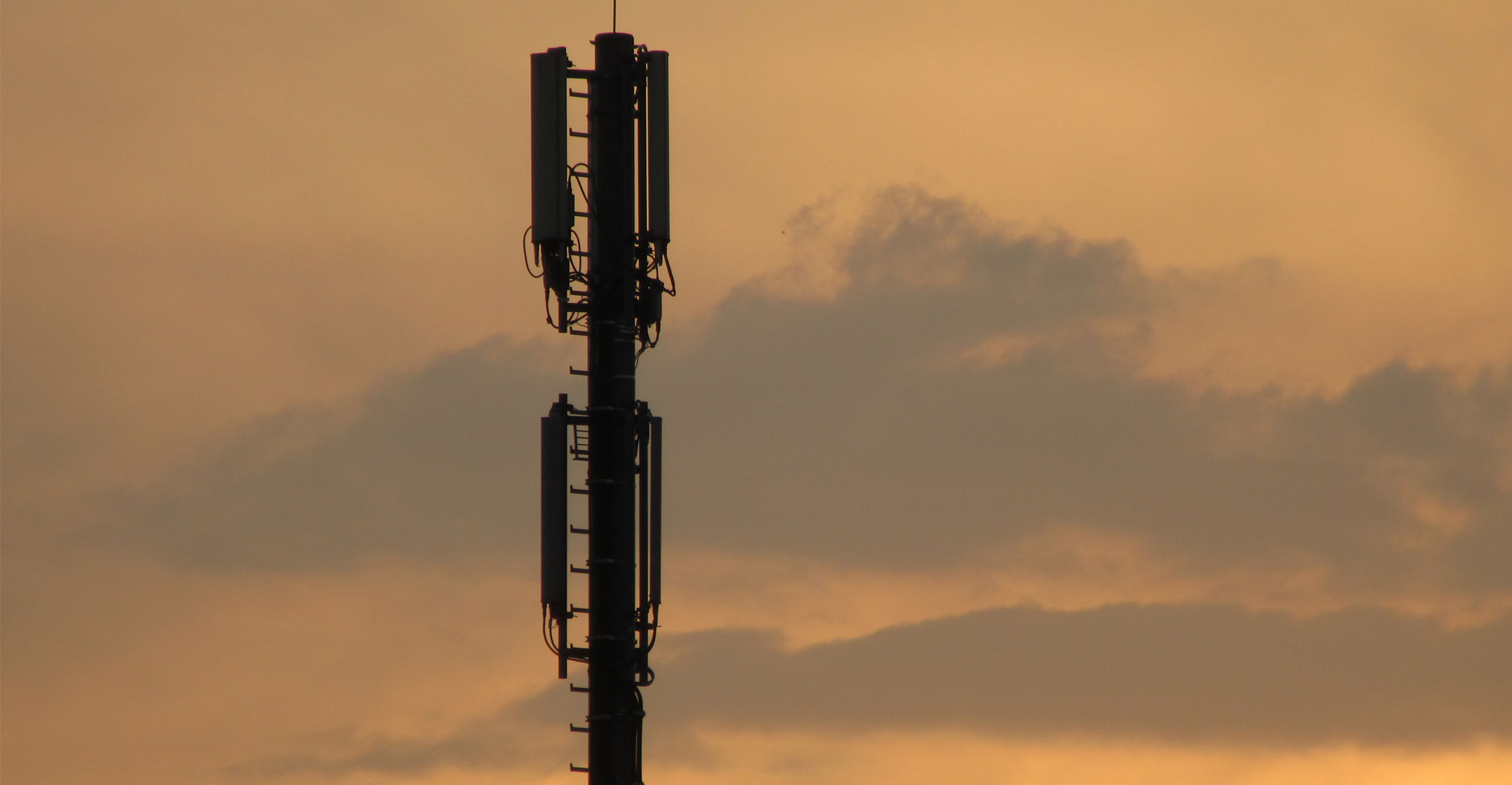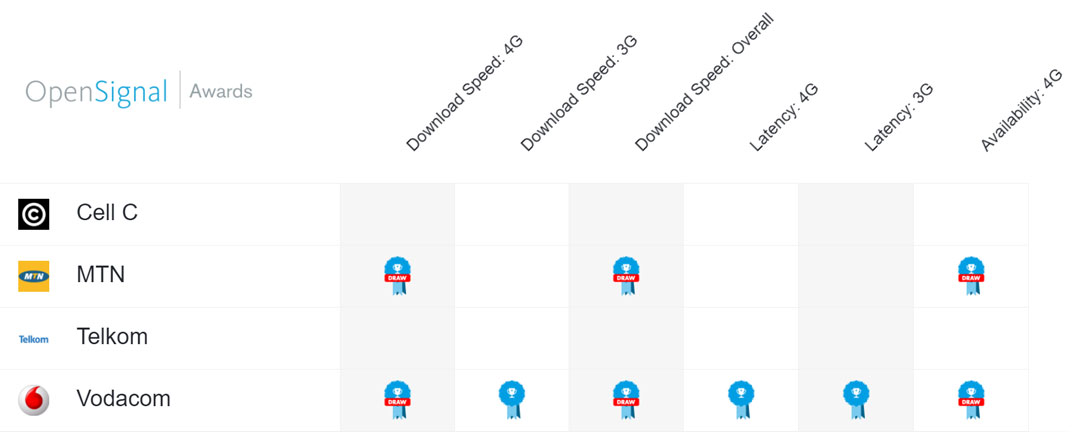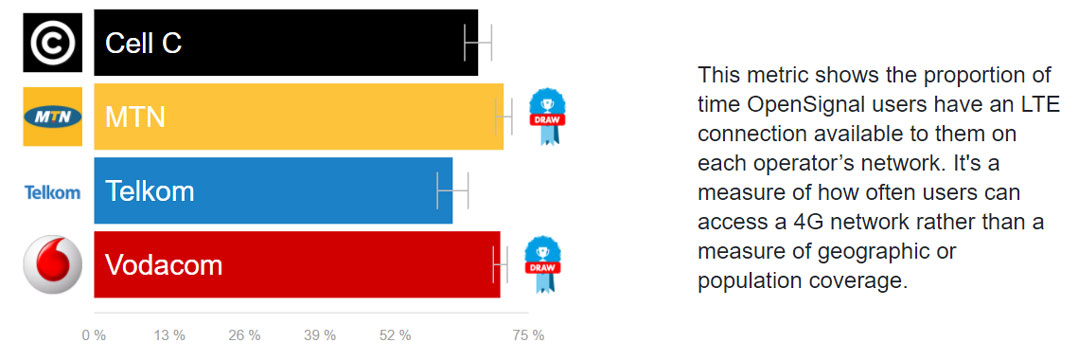
MTN and Vodacom have tied for first place in terms of mobile broadband coverage in South Africa, a comprehensive set of data points analysed by OpenSignal has shown.
The report by the company, which specialises in wireless coverage mapping through crowd-sourced data, analysed more than 289m data points from more than 20 000 devices across the Vodacom, MTN, Cell C and Telkom networks.
“What we found was a clear divide in our metrics between the two market leaders Vodacom and MTN and their two smaller rivals,” OpenSignal said. Vodacom led or tied in all metrics.
“Vodacom set itself apart with a trio of wins and an equal number of top-of-the-table draws in our six metrics. Vodacom stood out in OpenSignal’s 3G speed and latency categories, though it faced much stiffer competition from MTN in our core 4G metrics.”
MTN and Vodacom are in a close race for 4G dominance in South Africa.
“Despite Vodacom’s long list of wins, MTN was hot on its heels in nearly every metric. The two had the fastest LTE speeds in South Africa in our tests, both averaging downloads greater than 22Mbits/s. MTN and Vodacom were also neck and neck in our 4G availability results. Our users on both networks were able to latch onto their LTE signals more than 70% of the time.”
Twice as fast
The overall speeds measured on MTN and Vodacom were nearly twice as fast as the overall speeds on Cell C and Telkom.
In the 4G category, average download speeds for Cell C and Telkom were 13.8Mbit/s and 11.6Mbit/s respectively, scores that fell short of the global LTE average of 16.2Mbit/s.
MTN and Vodacom were essentially tied for first place in the LTE download rankings, providing average 4G connections of 22.6Mbit/s and 22.1Mbit/s respectively.

Although Vodacom and MTN have been most aggressive in rolling out 4G, South Africa overall ranked in the bottom third of 75 countries OpenSignal examined in a recent report.
“Mobile consumers in South Africa have four main operators to choose from, but two have broken away from the pack, providing the most consistent consumer mobile data experience in our metrics,” the company said.
“Vodacom and MTN were the standouts in our report, providing not only fast data speeds but also good LTE service reach. However, South Africa overall still has some work to do if it wants to catch up to its global peers in 4G capabilities. As a result, future investment in spectrum and infrastructure will be key in the region.”
The data was collected between May and July using OpenSignal and its partners’ apps. It collated customer experience data on both 3G and 4G networks.
Vodacom’s “aggressive technological approach” may be the reason it won at least a share of all six of OpenSignal’s awards in the report, it said.
“Vodacom is also currently showing the most forward momentum when it comes to adopting new LTE techniques. It’s now offering voice-over-LTE services as well as using more sophisticated smart antenna technologies (4×4 Mimo) and more complex modulation schemes (256QAM).”

However, all four networks provided a “solid” 3G experience. All four operators tested exceeded the global 3G download speed average of 4.4Mbit/s. Even in this area, however, Cell C and Telkom lagged MTN and Vodacom.
OpenSignal’s measurements showed a download speed range of 4.2Mbit/s to 4.7Mbit/s on the former pair’s 3G networks compared to a range of 5.6Mbit/s to 6.5Mbit/s on the latter two’s infrastructure.
Network latency
Network latency, which is a measure of a network’s reaction speed, was also similar across the operators, at least on 4G. OpenSignal data showed lag times of 41ms or less for each. Vodacom again stood out, however, with the lowest network latency average of 32.8ms. Vodacom also showed both the fastest 3G download speeds and lowest 3G latency.
OpenSignal users on Vodacom experienced nearly three times less 3G latency compared to those on Cell C.
Both Vodacom and MTN were statistically tied for the lead in OpenSignal’s 4G availability metric. This measures the proportion of time our users were able to connect to a particular network.
In the case of MTN and Vodacom, both provided users access to an LTE signal just over 70% of the time. “This is a good indication of a maturing 4G service.”
Results for Cell C and Telkom were measurably behind the market leaders. Users could find a 4G signal 66.3% on Cell C and 61.9% of the time on Telkom.
4G availability has a big impact on our overall speed metric, which factors in not only 3G and 4G speeds but the proportion of time users connect to each network. The more often consumers have access to faster LTE connections, the faster their everyday mobile data experience will be.
In the case of Vodacom and MTN, their high 4G availability scores and fast 3G and 4G speed tests compounded to produce overall speed metrics of 12.2Mbit/s and 11.3Mbit/s respectively. Meanwhile, neither Cell C nor Telkom had overall speed scores faster than 7Mbit/s.
In OpenSignal’s recent State of LTE report, which covered the January to March 2017 period, South Africa had an overall availability score of 62.7%, which ranked it among the bottom third of the 75 countries examined.
“That availability was on par with countries like Argentina, Indonesia and Israel. But South Africa’s mobile industry did beat several Western European economic powers, including France, Germany and Italy, all of which have been slow to build out their LTE signal reach.”
Since the LTE report was released, OpenSignal said it has seen availability scores improve in all four major operators’ 4G tests. — (c) 2017 NewsCentral Media




